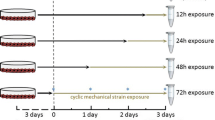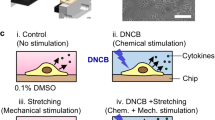Abstract
Background
The skin is constantly exposed to various external stimuli including humidity variations. Low humidity affects skin properties such as decreased water content of the stratum corneum, reduced skin elasticity, and itching. However, the effects of humidity on the skin cells are not completely understood. This study aimed to investigate how low humidity affects keratinocytes of the skin.
Methods and results
In the present study, the effects of dry environment on the gene expression profile of epidermal keratinocytes were demonstrated using a three-dimensional skin model (3D-skin), composed of keratinocytes. Exposure of 3D-skin to low humidity (relative humidity ~ 10%) increased the expression levels of various genes, including those related to signal transduction and immune system. Accordingly, p38 mitogen-activated protein kinase (MAPK) signaling in keratinocytes of the 3D-skin was activated in response to low humidity for 30 min. Additionally, several chemokines, such as chemokine (C-X-C motif) ligand 1 (CXCL1) and Chemokine (C-C motif) ligand 20 (CCL20), were up regulated after 3 h of exposure to low humidity.
Conclusions
We hypothesize that increased chemokine production may affect the immune system of the whole skin through chemoattractants. Our findings imply that keratinocytes sense low humidity and resultant activation of some cell-signaling pathways leads to variations in gene expression profiles including various chemokines. We provide evidence that keratinocytes adapt to external humidity variations.




Similar content being viewed by others
Abbreviations
- 3D-skin:
-
Three dimensional skin model
- RH:
-
Relative humidity
- TEWL:
-
Transepidermal water loss
- SC:
-
Stratum corneum
- DEGs:
-
Differentially expressed genes
- MAPK:
-
Mitogen-activated protein kinases
- KEGG:
-
Kyoto Encyclopedia of Genes and Genomes
- CXCL1:
-
Chemokine (C-X-C motif) ligand 1
- CXCL3:
-
Chemokine (C-X-C motif) ligand 3
- CXCL8:
-
Chemokine (C-X-C motif) ligand 8
- CXCL10:
-
Chemokine (C-X-C motif) ligand 10
- CCL20:
-
Chemokine (C-C motif) ligand 20
- CCL28:
-
Chemokine (C-C motif) ligand 28
- IL-1:
-
Interleukin-1
- PI3K:
-
Phosphatidylinositol 3-kinase
- TNF:
-
Tumor necrosis factor
References
Proksch E, Brandner JM, Jensen J-M (2008) The skin: an indispensable barrier. Exp Dermatol 17:1063–1072. https://doi.org/10.1111/j.1600-0625.2008.00786.x
Altemus M, Rao B, Dhabhar FS, Ding W, Granstein RD (2001) Stress-induced changes in skin barrier function in healthy women. J Investig Dermatol 117:309–317. https://doi.org/10.1046/j.1523-1747.2001.01373.x
Biniek K, Levi K, Dauskardt RH (2012) Solar UV radiation reduces the barrier function of human skin. Proc Natl Acad Sci 109:17111–17116. https://doi.org/10.1073/pnas.1206851109
Egawa M, Oguri M, Kuwahara T, Takahashi M (2002) Effect of exposure of human skin to a dry environment. Skin Res Technol 8:212–218. https://doi.org/10.1034/j.1600-0846.2002.00351.x
Chou T-C, Lin K-H, Wang S-M et al (2005) Transepidermal water loss and skin capacitance alterations among workers in an ultra-low humidity environment. Arch Dermatol Res 296:489–495. https://doi.org/10.1007/s00403-005-0541-4
T L, K A, B.-G D, et al (2002) Ocular, nasal, dermal and general symptoms among commercial airline crews. Int Arch Occup Environ Health 75:475–483. https://doi.org/10.1007/s00420-002-0330-8
Silverberg JI, Hanifin J, Simpson EL (2013) Climatic factors are associated with childhood eczema prevalence in the United States. J Invest Dermatol 133:1752–1759. https://doi.org/10.1038/jid.2013.19
Hara M, Ma T, Verkman AS (2002) Selectively reduced glycerol in skin of aquaporin-3-deficient mice may account for impaired skin hydration, elasticity, and barrier recovery. J Biol Chem 277:46616–46621. https://doi.org/10.1074/jbc.M209003200
Sato J, Denda M, Ashida Y, Koyama J (1998) Loss of water from the stratum corneum induces epidermal DNA synthesis in hairless mice. Arch Dermatol Res 290:634–637. https://doi.org/10.1007/s004030050364
Denda M, Sato J, Tsuchiya T, Elias PM, Feingold KR (1998) Low humidity stimulates epidermal DNA synthesis and amplifies the hyperproliferative response to barrier disruption: implication for seasonal exacerbations of inflammatory dermatoses. J Investig Dermatol 111:873–878. https://doi.org/10.1046/j.1523-1747.1998.00364.x
Denda M, Sato J, Masuda Y et al (1998) Exposure to a dry environment enhances epidermal permeability barrier function. J Investig Dermatol 111:858–863. https://doi.org/10.1046/j.1523-1747.1998.00333.x
Hosoi J, Hariya T, Denda M, Tsuchiya T (2000) Regulation of the cutaneous allergic reaction by humidity. Contact Dermatitis 42:81–84. https://doi.org/10.1034/j.1600-0536.2000.042002081.x
Ashida Y, Ogo M, Denda M (2001) Epidermal interleukin-1 alpha generation is amplified at low humidity: implications for the pathogenesis of inflammatory dermatoses. Br J Dermatol 144:238–243. https://doi.org/10.1046/j.1365-2133.2001.04007.x
Katoh M, Hamajima F, Ogasawara T, Hata K (2009) Assessment of human epidermal model LabCyte EPI-MODEL for in vitro skin irritation testing according to European Centre for the Validation of Alternative Methods (ECVAM)-validated protocol. J Toxicol Sci 34:327–334.
Love MI, Huber W, Anders S (2014) Moderated estimation of fold change and dispersion for RNA-seq data with DESeq2. Genome Biol. https://doi.org/10.1186/s13059-014-0550-8
Kanda Y (2013) Investigation of the freely available easy-to-use software ‘EZR’ for medical statistics. Bone Marrow Transplant 48:452–458. https://doi.org/10.1038/bmt.2012.244
Kanehisa M, Araki M, Goto S et al (2007) KEGG for linking genomes to life and the environment. Nucleic Acids Res 36:D480–D484. https://doi.org/10.1093/nar/gkm882
Moens U, Kostenko S, Sveinbjørnsson B (2013) The role of mitogen-activated protein kinase-activated protein kinases (MAPKAPKs) in inflammation. Genes 4:101–133. https://doi.org/10.3390/genes4020101
Thien A, Prentzell MT et al (2015) TSC1 activates TGF-β-Smad2/3 signaling in growth arrest and epithelial-to-mesenchymal transition. Dev Cell 32:617–630. https://doi.org/10.1016/j.devcel.2015.01.026
Palomino DC, Marti LC (2015) Chemokines and immunity. Einstein (Sao Paulo) 13:469–473. https://doi.org/10.1590/S1679-45082015RB3438
Mabuchi T, Chang TW, Quinter S, Hwang ST (2012) Chemokine receptors in the pathogenesis and therapy of psoriasis. J Dermatol Sci 65:4–11. https://doi.org/10.1016/j.jdermsci.2011.11.007
Sisirak V, Vey N, Vanbervliet B et al (2011) CCR6/CCR10-mediated plasmacytoid dendritic cell recruitment to inflamed epithelia after instruction in lymphoid tissues. Blood 118:5130–5140. https://doi.org/10.1182/blood-2010-07-295626
Sokol CL, Luster AD (2015) The chemokine system in innate immunity. Cold Spring Harbor Perspect Biol 7:a016303. https://doi.org/10.1101/cshperspect.a016303
Hirth M, Gandla J, Höper C et al (2020) CXCL10 and CCL21 promote migration of pancreatic cancer cells toward sensory neurons and neural remodeling in tumors in mice, associated with pain in patients. Gastroenterology 159:665-681.e613. https://doi.org/10.1053/j.gastro.2020.04.037
Kadomoto S, Izumi K, Mizokami A (2020) The CCL20-CCR6 axis in cancer progression. Int J Mol Sci 21:5186. https://doi.org/10.3390/ijms21155186
Mosser DM, Edwards JP (2008) Exploring the full spectrum of macrophage activation. Nat Rev Immunol 8:958–969. https://doi.org/10.1038/nri2448
Marzano AV, Ortega-Loayza AG, Heath M, Morse D, Genovese G, Cugno M (2019) Mechanisms of inflammation in neutrophil-mediated skin diseases. Front Immunol 10:1059. https://doi.org/10.3389/fimmu.2019.01059
Hughes CE, Nibbs RJB (2018) A guide to chemokines and their receptors. FEBS J 285:2944–2971. https://doi.org/10.1111/febs.14466
Zlotnik A, Yoshie O (2000) Chemokines. Immunity 12:121–127. https://doi.org/10.1016/s1074-7613(00)80165-x
De Filippo K, Dudeck A, Hasenberg M et al (2013) Mast cell and macrophage chemokines CXCL1/CXCL2 control the early stage of neutrophil recruitment during tissue inflammation. Blood 121:4930–4937. https://doi.org/10.1182/blood-2013-02-486217
Rajarathnam K, Schnoor M, Richardson RM, Rajagopal S (2019) How do chemokines navigate neutrophils to the target site: dissecting the structural mechanisms and signaling pathways. Cell Signal 54:69–80. https://doi.org/10.1016/j.cellsig.2018.11.004
Korbecki J, Kojder K, Siminska D et al (2020) CC chemokines in a tumor: a review of Pro-Cancer and anti-cancer properties of the ligands of receptors CCR1, CCR2, CCR3, and CCR4. Int J Mol Sci. https://doi.org/10.3390/ijms21218412
Gruber CN, Patel RS, Trachtman R et al (2020) Mapping systemic inflammation and antibody responses in multisystem inflammatory syndrome in children (MIS-C). Cell 183(982–995):e914. https://doi.org/10.1016/j.cell.2020.09.034
Rawlings A, Harding C, Watkinson A, Banks J, Ackerman C, Sabin R (1995) The effect of glycerol and humidity on desmosome degradation in stratum corneum. Arch Dermatol Res 287:457–464. https://doi.org/10.1007/BF00373429
Sato J, Denda M, Nakanishi J, Koyama J (1998) Dry condition affects desquamation of stratum corneum in vivo. J Dermatol Sci 18:163–169. https://doi.org/10.1016/s0923-1811(98)00037-1
Ashida Y, Denda M (2003) Dry environment increases mast cell number and histamine content in dermis in hairless mice. Br J Dermatol 149:240–247. https://doi.org/10.1046/j.1365-2133.2003.05408.x
Acknowledgements
The authors are grateful to Mr. Masakatsu Ota for advice on experimental design. We thank Dr. Tetsuro Iwanaga for useful discussions. The authors would like to thank Ms. Manami Tanaka for technical assistance with the experiments.
Funding
This work was supported by Kracie Home Products, Ltd.
Author information
Authors and Affiliations
Contributions
KS and MH-C contributed to the study conception and design. KS performed the experiments, and analyzed the data. KS and MH-C wrote the manuscript. All authors read and approved the final manuscript.
Corresponding author
Ethics declarations
Conflict of interest
The authors declare no competing interests.
Ethical approval
Not applicable.
Consent to participate
Not applicable.
Consent for publication
Not applicable.
Additional information
Publisher's Note
Springer Nature remains neutral with regard to jurisdictional claims in published maps and institutional affiliations.
Rights and permissions
About this article
Cite this article
Shinohara, K., Hara-Chikuma, M. Low humidity altered the gene expression profile of keratinocytes in a three-dimensional skin model. Mol Biol Rep 49, 7465–7474 (2022). https://doi.org/10.1007/s11033-022-07549-0
Received:
Accepted:
Published:
Issue Date:
DOI: https://doi.org/10.1007/s11033-022-07549-0




